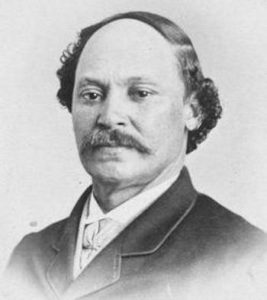
Robert S. Duncanson
The birth of Robert S. Duncanson in 1821 is celebrated on this date. He was a Black artist.
From Seneca, New York, his parents were both Mulatto. Robert Seldon Duncanson’s father earned a living as a handyman and house painter. This background may have allowed Duncanson to learn the craft and art of mixing pigments informally, working with brushes and paints, and preparing and repairing surfaces.
He is considered a self-taught artist. Duncanson decided early in his life that art would become his career and not just a hobby. In 1839, the Freedman’s Aid Society of Ohio raised money to send him to Glasgow, Scotland, to study painting. Upon his return, he lived in Cincinnati, where portrait and landscape painting were in demand.
Duncanson was exposed to the prominent Hudson River School through the Western Art Union. By 1842 he was ready to exhibit his work in public. His first exhibition was sponsored by the Society for the Promotion of Useful Knowledge and opened the door for Duncanson to increase his visibility. He accepted several portrait commissions of abolitionists and other prosperous Cincinnati citizens. In 1853, he went to Europe and then returned to paint classical motifs into his landscapes, obviously influenced by his European exposure to Neo-Classicism. Duncanson’s artwork has become a useful tool in teaching art students about the history of African American artists. During the American Civil War, he was in England and Scotland.
Although not very well known by the general public, Duncanson significantly impacted American art. As the first American painter to reside in Canada and focus on its landscape, Duncanson’s influence has also been felt there. At a gallery showing in Harlem, the New York Amsterdam News called the works by Duncanson “pioneering.” It is not the pioneering genre he chose to paint in; it was the subtle way he infused his paintings with an African American sensibility without creating what the art world would categorize as African American paintings.
Audiences looking at Duncanson’s work must concentrate, beyond the obvious associations with themes of landscape and idealized lands, to see the commentary on a post-Civil War America and a socially aware Black artist. Instead, Richard Powell of American Visions says that Duncanson’s success is a “victory over society’s presumptions of what African American artists should create.”
Robert Duncanson suffered a mental breakdown and died on December 21, 1872.
A History of African American Artists from 1792 to Present
by Romare Bearden & Harry Henderson
Copyright 1993 by Romare Bearden & Harry Henderson
Pantheon Books, NY
ISBN 0-394-57016-2
University of Missouri Press, 1993;
Thomas Cole House, 2011
Antiques Magazine,
November 2011